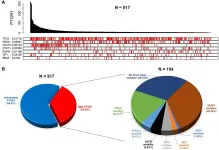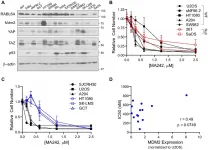Dengue immune function discovery could benefit much-needed vaccine development
Novel approach could aid new vaccines as global dengue virus infections far surpass COVID-19
2021-05-24
(Press-News.org) Despite a daunting more than 130 million cases of SARS-CoV-2 infections to date worldwide, another global pathogen - the Aedes mosquito-borne dengue virus - saw a record number of over 400 million cases in 2019. But vaccine development has been challenging due to the need to protect equally against all four dengue strains. The discovery of new possible biomarkers to predict clinical and immune responses to dengue virus infection, published today in Nature Communication, could be critical to informing future vaccines.
As with SARS-CoV-2 infection, the effects of dengue virus infection can range from asymptomatic to severe disease that can be fatal. Climate change has expanded the viruses' geographic distribution far beyond tropical areas like Southeast Asia and Latin America to the southern U.S. and Europe. Only one vaccine, Dengvaxia, has been approved for a subset of at-risk individuals in endemic areas.
This study, led by University of Vermont (UVM) Associate Professor of Microbiology and Molecular Genetics (MMG) Sean Diehl, Ph.D., set out to determine biomarker candidates and predictors for clinical and immunological responses resulting from dengue infection. Previous research published by Diehl and MMG Chair Beth Kirkpatrick, M.D., director of the UVM Vaccine Testing Center, has shown how a dengue vaccine being developed together with Johns Hopkins and the National Institutes of Health activates an immune response that protects against challenge with this dengue virus.
Live, weakened viruses are the basis for the most-effective and longest-lasting vaccines against many viral diseases. This "live attenuated" approach is used in the next-generation dengue vaccine that is being co-developed at UVM. To better understand how live attenuated dengue viruses turn on the immune system, Diehl and colleague John Hanley, Ph.D., a UVM research specialist, in collaboration with Kirkpatrick and the Vaccine Testing Center, investigated which genes are activated or repressed in the immune cells from subjects exposed to a well-characterized and safe live attenuated dengue virus. Hanley developed a new statistical approach to integrate the genomics data with the extensive clinical data collected during the careful monitoring of dengue virus-exposed study participants.
The team found strong correlations between the activation of specific immune genes and the ability of participants' immune systems to turn on early cellular defense mechanisms and make protective antibodies against dengue virus.
"These data offer new potential biomarkers for characterizing dengue virus infection and novel pathways that could be leveraged to combat viral replication," says Diehl. "Our results also gave us some clues about how we might be able to boost protective immune responses, which is the goal of developing effective vaccines."
Diehl adds that for some of the genes identified in this study, little is known about their role in the response against dengue virus.
"This is very exciting, because it could lead to new ways to fight dengue, so we are now investigating these in the lab" says Diehl.
He and Kirkpatrick are also working to determine how long protective immunity lasts after receiving a dengue vaccine and are in the process of identifying volunteers who received the NIH-developed dengue vaccine up to 11 years ago to obtain a current blood sample for further testing.
"A durable protective immune response is the goal of a good vaccine," says Kirkpatrick.
INFORMATION:
ELSE PRESS RELEASES FROM THIS DATE:
2021-05-24
LEBANON, NH - By 2030, pancreatic ductal adenocarcinoma (PDAC), the most lethal form of pancreatic cancer, is projected to become the second leading cause of cancer-related deaths in the United States. Not only are therapeutic options limited, but nearly half of all PDAC patients who have their tumors removed surgically experience disease recurrence within a year, despite receiving additional chemotherapy. For more advanced stages, only about one-third of patients have a limited response to approved chemotherapy.
A team of researchers led by Dartmouth and Dartmouth-Hitchcock's Norris ...
2021-05-24
Within the European Union alone, about three million people are affected by an autism spectrum disorder (ASD). Some are only mildly affected and can live independent lives. Others have severe disabilities. What the different forms have in common is difficulty with social interaction and communication, as well as repetitive-stereotypic behaviors. Mutations in a few hundred genes are associated with ASD. One of them is called Cullin 3, and it is a high-risk gene: A mutation of this gene almost certainly leads to a disorder. But how exactly does this gene affect the brain? To learn more about it, Jasmin Morandell and Lena Schwarz, PhD students at Professor Gaia Novarino's research group, ...
2021-05-24
SILVER SPRING, Md.--People who are successful at weight-loss maintenance spend less time sitting during the week and weekends compared to weight-stable individuals with obesity, according to a paper published online in Obesity, The Obesity Society's flagship journal. This is the first study to examine time spent in various sitting activities among weight-loss maintainers.
Prior findings from 2006 in the National Weight Control Registry indicated that weight-loss maintainers watched significantly less television than controls, but other sitting activities were not examined. In the current study, weight-loss maintainers did not significantly differ from controls in reported weekly sitting time ...
2021-05-24
SILVER SPRING, Md.-- Multi-factorial metabolic and inflammatory abnormalities in obesity, independently or in combination, seems to be the critical biological link of obesity, cancer and racial/gender health disparities. However, the specific cross-talk between these factors remain elusive. Because of the extraordinary relevance in understanding the relationship between obesity-associated inflammation and comorbidities with cancer development, progression and intervention, three new papers emphasizing different aspects of the obesity and cancer connection can be found in the latest online issue of Obesity, ...
2021-05-24
A study of 1,095 patients hospitalized with COVID-19 discovered that two easily measurable signs of health - respiration rate and blood-oxygen saturation - are distinctly predictive of higher mortality. Notably, the authors said, anyone who receives a positive COVID-19 screening test can easily monitor for these two signs at home.
This context is lacking in current guidance from the Centers for Disease Control and Prevention, which tells people with COVID-19 to seek medical attention when they experience overt symptoms such as "trouble breathing" and "persistent pain or pressure in the chest" - indications that may be absent even when respiration and blood oxygen have reached dangerous levels, the authors ...
2021-05-24
New research indicates that certain anti-cancer therapies may hasten cellular aging, where changes in the DNA of patients may contribute to greater inflammation and fatigue. The findings are published by Wiley early online in CANCER, a peer-reviewed journal of the American Cancer Society.
Gene activity is often adjusted during life through epigenetic changes, or physical modifications to DNA that do not involve altering the underlying DNA sequence. Some individuals may experience epigenetic age acceleration (EAA) that puts them at a higher risk of age-related ...
2021-05-24
Oncotarget published "Urine protein biomarkers of bladder cancer arising from 16-plex antibody-based screens" which reported that the current study examines urine samples from 66 subjects, comprising of 31 Urology clinic controls and 35 bladder cancer patients, using a Luminex based screening platform.
ELISA validation was carried out for the top 4 prospective urine biomarkers using an independent cohort of 20 Urology clinic controls and 60 bladder cancer subjects.
Eight of these urine proteins were able to differentiate BC from control urine with ROC AUC values exceeding 0.70 at p < 0.0001, with specificity values exceeding 0.9. Upon ELISA validation, urine IL-1α, IL-1ra, and IL-8 were able to distinguish ...
2021-05-24
Oncotarget published "The acylfulvene alkylating agent, LP-184, retains nanomolar potency in non-small cell lung cancer carrying otherwise therapy-refractory mutations" which reported that KEAP1 mutant NSCLCs further activate NRF2 and upregulate its client PTGR1. LP-184, a novel alkylating agent belonging to the acylfulvene class is a prodrug dependent upon PTGR1.
The authors hypothesized that NSCLC with KEAP1 mutations would continue to remain sensitive to LP-184. LP-184 demonstrated highly potent anticancer activity both in primary NSCLC cell lines and in those originating from brain metastases of primary lung cancers.
LP-184 activity correlated with PTGR1 transcript levels but was independent of mutations in key oncogenes and tumor ...
2021-05-24
Oncotarget published "Prognostic and therapeutic value of the Hippo pathway, RABL6A, and p53-MDM2 axes in sarcomas" which reported that herein the authors evaluate expression of TAZ and YAP, the p53-MDM2 axis, and RABL6A, a novel oncoprotein with potential ties to both pathways, in sarcomas of different histological types.
Immunohistochemical staining of a tissue microarray including 163 sarcomas and correlation with clinical data showed that elevated YAP and TAZ independently predict worse overall and progression-free survival, respectively.
In the absence of p53 expression, combined TAZ and YAP expression adversely affect overall, progression free, and metastasis free survival ...
2021-05-24
Regular consumption of milk is not associated with increased levels of cholesterol, according to new research.
A study published in the International Journal of Obesity looked at three large population studies and found that people who regularly drank high amounts of milk had lower levels of both good and bad cholesterol, although their BMI levels were higher than non-milk drinkers. Further analysis of other large studies also suggests that those who regularly consumed milk had a 14% lower risk of coronary heart disease.
The team of researchers took a genetic approach to milk consumption by looking at a variation in the lactase gene associated with digestion of milk sugars known as lactose.
The study identified that having the genetic variation where people can digest ...
LAST 30 PRESS RELEASES:
[Press-News.org] Dengue immune function discovery could benefit much-needed vaccine development
Novel approach could aid new vaccines as global dengue virus infections far surpass COVID-19




